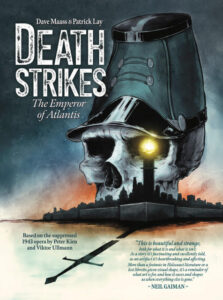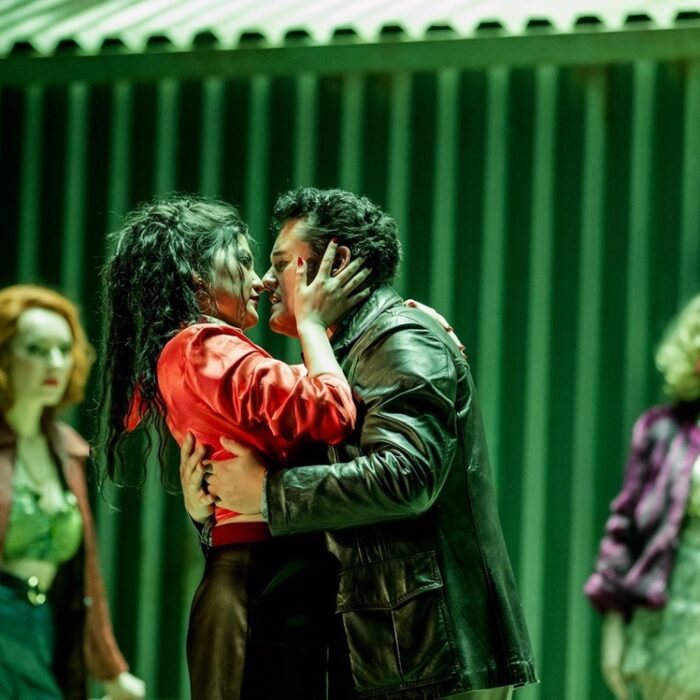
Book Review: Death Strikes: The Emperor of Atlantis
A New Graphic Novel Documents the Powerful Story of a Forgotten Opera’s creation in a Nazi Concentration Camp
By Matt CostelloThe world of what is considered recognized literature and art has come a long way since the days of completely disregarding dime comics snatched from the spinner rack at the corner candy store, all set to be instantly disposable.
And — oh the lucky few who preserved those “classics,” featuring caped heroes, now worth not-so-small fortunes.
No, with advent of the term “graphic novel” some sixty years ago, the comic book has evolved into a respected art form, unique in its power and with an emotional range that makes it comparable to any other narrative art.
The classic example of this is Art Spiegelman’s “Maus: A Survivor’s Tale,” based on Spiegelman’s interview with his father, a Holocaust survivor. The memoir used comic panels, dialogue balloons, and in this case, cats and mice to bring his father’s terrible memories and important history to life.
It was a long way from documenting the slam-bam exploits of heroes with capes, all in color for a thin dime.
And – it should be mentioned — there have even been highly respected graphic novels that do endeavor to bridge that world of superheroes and art, such as Alan Moore’s brilliant “Watchmen.”
Which is to say, that the marriage of a little-known and forgotten opera created in the Terezin Concentration Camp and the medium of the graphic novel should not seem unusual at all.
Never Saw Another Butterfly
When I was a teacher, I introduced my middle-schoolers to a rather remarkable book: “I Never Saw Another Butterfly.”
The book collected the poems and art work from the children of the Terezin Camp. As a teacher, it was a powerful moment to be with those suburban children, discussing those other remarkable and beautiful and doomed children, prisoners all, from so many decades ago who, as one child’s poem put it, “never saw another butterfly.”
So, well, I was more than eager to review “Death Strikes: The Emperor of Atlantis,” by Dave Maass and Patrick Lay, published by Berger Books and Dark Horse Comics.
The story for the 128-page graphic novel is based on the remarkable creation of the seldom-heard or performed opera.
When they were prisoners in the Nazi’s “artistic” Terezin Concentration camp, composer Viktor Ullmann and librettist Peter Kien decided to create the opera while prisoners.
In the work, the mythological Atlantis served as a commentary and reflection of the world of the brutal and deadly concentration camp. “The Emperor of Atlantis or the Disobedience of Death” (Die Kaiser von Atlantis) was never performed while the creators lived, both perishing in the camp.
Atlantis
The graphic novel, with both delicate and powerful drawings, tells the tale of the opera’s story, while also highlighting the more than grim reality of its creation.
The back story for the one-act opera is that Atlantis never sank and instead, evolved into a technologically advanced tyranny. When a buffoonish Emperor – as such Emperors are won’t do – orders all-out war, everyone on Atlantis wages war with everyone else.
But that proves all too much for Death, who goes on strike. So, people kill and are killed, and yet — one might have guessed it – no one ever dies.
The artist Patrick Lay described for OperaWire how this powerful story both reflected the place where it was being created, and at the same time, in the way of fantasy and satire, transcends that:
“’Death Strikes: The Emperor of Atlantisis’ is our adaptation of a censored opera, written in the Nazi concentration camp at Terezín in 1943. The story is about Life and Death, run ragged by endless war and pushed over the edge by a new battle-strategy: every citizen against the other. Death goes on strike in protest, leaving the world in limbo: everyone fights, no one dies.”
For writer David Maass the challenge was to capture the power of musical theatre to the prose and art format of the graphic novel, in this case highlighting how the book mirrors a powerful auditory effect that opens the opera:
“The book opens just like the opera – a simple electronic speaker on an empty stage, doing very little until suddenly it blasts a greeting at top volume, knocking the audience out of their seats. That ‘HALLO, HALLO!’ are the most unforgettable four notes in the whole opera, so we wanted to recreate that sensation of having your attention violently seized, an achtung! achtung! moment. Now, the Loudspeaker has your undivided focus as it introduces the cast of characters in an otherwise very traditional way.”
They are both more than well-suited to tackling this unique and important project. Maas is an Electronic Frontier Foundation journalist with features in Wired, Vice, Rolling Stone and The Daily Beast among others. He has said his hope for this remarkable book is to “challenge the tyrants of today.”
His co-creator, artist Patrick Lay teaches comics at Columbus College of Art and Design, and he has used both the architecture of Terezin and Prague, as well as composer Peter Kien’s own art work from the camp to create visuals that match both the madness, horror and farcical nature of the genre-bending satire.
The opera’s creators did not live to see it performed. Despite Terezin being a staged as a show-place for the Third Reich — highlighting the artist inmates and their apparent “creative freedom” — few of its inmates lived.
The book includes original designs from the opera’s creators, a historical essay on the sinister nature of this pretend “haven” for its concentration camp artists as well as photos from the period.
The Impact
And the impact of reading this graphic novel cannot be overestimated. I was offered an advance PDF to read, but I knew for this book, for this tale, its visuals, its meaning — it was something I wanted to hold in my hands.
The experience of doing that is beyond moving and powerful, getting caught up in the story, never for once forgetting its dire origin and the base fact that it was born from an ultimately deadly concentration camp and two brave creators who did not survive. The reality of this true story both influences and amplifies the graphic novel’s impact.
And is it ever powerful!
The story with its mix of sci-fi, horror, satire and comedy is instantly gripping in a way you may not expect with fact and fantasy, satire and sadness sitting side by side. And the art is a mix of shadows and light, of exaggeration and starkness, bringing the world of the graphic novel alive. But, more importantly, it transports one to the terrible place where it was imagined, created and yet….never performed.
The book is also, quite simply, a work of art unto itself. And at the same time it is also an important historical artifact, bringing this so very little-known opera to the attention to both fans of the genre as well as the larger audience of those who care about art, its history and its special role in human existence.
I was so appreciative to have the physical book in hand, and then to be guided into the many places it takes you visually, story-wise, and to such a dark period in human history where, well, amazingly there could be art.
There could be opera.
And somehow, while even at a place where butterflies were never to be seen again, they could always be imagined, could always be written about. And yes, to be sure — never forgotten.
Categories
Reviews


